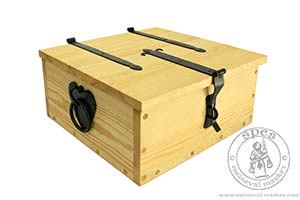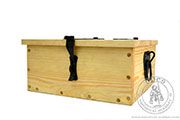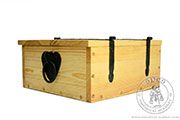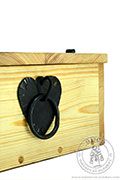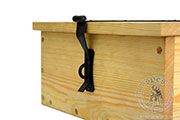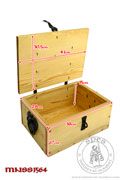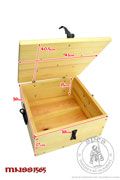If you wish to adjust your cookie preferences for this website, you can do so using your browser settings.



Category: Furniture > furniture
Chest for small items
Chest for small items
Century: XIII, XIV, XV, XVI| CODE | Material |
Standard
|
Price | |
| MNsS1564 | Pine | Mixed | 250.00 EUR |
|
| MNsS1565 | Pine | Mixed | 250.00 EUR |
|
Lowest price in the last 30 days
See how to place an order for several people
A wooden box used to store valuable items or used as a gift wrapping, e.g. in the form of a set of historical glasses or glasses and bottles.
It is made of pine wood and has decorative fittings made of blackened steel. Each of them is finished with a decorative pattern. On the sides of the box there are heart-shaped fittings with round handles for easy carrying.
This type of furniture was hewn from various types of wood and has been used since ancient times. The chests differed from each other depending on the wealth of the owners and the fashion in a given period, country or region. They once served as today's wardrobes or dressers. Trunks were similar in shape, but most often with a rounded lid. However, this type of furniture was mainly used for transporting things.
Chest of this size will be great not only as a glass storage, but also you can hide your valuables in it or use it as a storage for the most necessary things during a historical event.
The wooden box was based on historical sources from the Middle Ages. For the sake of convenience, however, round handles have been added on the sides to allow easy carrying.
The box is available in two versions:
MNsS1564 - smaller
MNsS1565 - larger
The dimensions of each of them are shown in the photos.
It is possible to impregnate the ordered crate for a small surcharge. This type of protection will protect the wood against various external factors. Remember, however, that after using the oil, it will slightly change color. You can see the difference here.
It is worth picking a medieval padlock or ordering an additional material filling, e.g. with printed linen or straw. If you are interested in this option, please contact us before making a purchase.
Source for a medieval case
Inspiration to create our chest of this size and shape were small boxes, carried in the hands by characters from the so-called Romance of Alexander, from the turn of the 13th and 14th centuries. On the pages of this richly decorated manuscript, there are also large chests, of which fittings inspired us to create our smaller version.Chests - history of the former wardrobe
Chests, as everyday furniture, were known already in ancient times. Then they took very simple forms. They had gable lids and were characterized by the lack of convexity.In the Middle Ages, their design changed somewhat. In addition to the typical, massive chests, the sources contain furniture of the so-called panel-type. Such boxes were much lighter than the original ones and gave greater possibilities of decorating both the lid and the sides. The evolution of chests began at the end of the 15th century. They began to grow and become more elaborate (have drawers, shelves), and also shrink in size, becoming more and more enriched and expensively decorated.
This type of furniture gained the greatest popularity during the Renaissance. In Italy, fashion for decorative dowry boxes has developed. Over time, metal began to displace wood, and the closures of the boxes became more and more complicated.
In the following centuries, they began to be replaced for dressers, cupboards, and finally wardrobes. These wooden works of art have survived to this day only in folk culture as dowry boxes.





 Female Clothing
Female Clothing Male clothing
Male clothing Accessories
Accessories
 Tents
Tents Armament
Armament HMB Line
HMB Line Miscellaneous
Miscellaneous Rent
Rent In stock
In stock Special Offers
Special Offers Search
Search Your Account
Your Account About us
About us Sizing
Sizing How to buy
How to buy Blog
Blog Links
Links Events
Events
